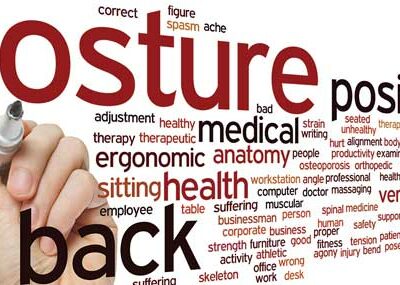Posture is the position in which we hold our bodies while standing, sitting, or lying down. Good posture is the correct alignment of body parts supported by the right amount of muscle tension
against gravity. Without posture and the muscles that control it, we would simply fall to the ground.

Normally, we do not consciously maintain normal posture. Instead, certain muscles do it for us, and we don’t even have to
think about it. Several muscle groups, including the hamstrings and large back muscles, are critically important in maintaining good posture. While the ligaments help to hold the skeleton together, these postural muscles, when functioning properly, prevent the forces of gravity from pushing us over forward. Postural muscles also maintain our posture and balance during movement.
Good posture helps us stand, walk, sit, and lie in positions that place the least strain on supporting muscles and ligaments during movement and weight-bearing activities.
Correct posture:
- Helps us keep bones and joints in correct alignment so that our muscles are used correctly, decreasing the abnormal wearing of joint surfaces that could result in degenerative arthritis and joint pain.
- Reduces the stress on the ligaments holding the spinal joints together, minimizing the likelihood of injury.
- Allows muscles to work more efficiently, allowing the body to use less energy and, therefore, preventing muscle fatigue.
- Helps prevent muscle strain, overuse disorders, and even back and muscular pain.
The fact is, bad posture creates chronic pain in nearly 80% of the people who appear with chronic pain as their chief complaint. This is particularly true on the opposite ends of the spine, the neck and low back.
Our practitioners @ Langer Chiropractic and Soft Tissue Therapy will evaluate the overall alignment of your body, from the head to toes. The presence of any variations from the ideal postural alignment can help us determine regions that may be weak or tight. We will work with you to develop customized techniques to improve your posture.
Some of these techniques may include specific spinal adjustments, gentle stretches, core strengthening exercises and advanced techniques to re-train your body and muscles in simple patterns of movement. Your body will ‘relearn’ what it was always meant to do.
To maintain proper posture, you need to have adequate muscle flexibility and strength, normal joint motion in the spine and other body regions, as well as efficient postural muscles that are balanced on both sides of the spine. In addition, you must recognize your postural habits at home and in the workplace and work to correct them, if necessary. By putting this knowledge into practice you can prevent the anatomical changes that can develop if poor posture is left uncorrected.


 50 WAYS TO TAKE A BREAK
50 WAYS TO TAKE A BREAK